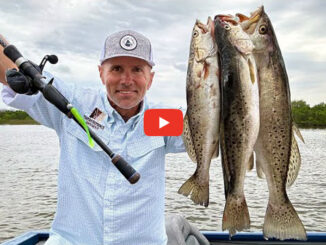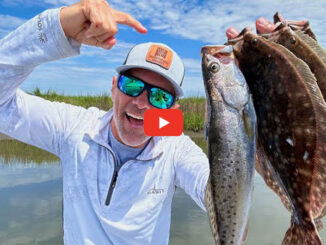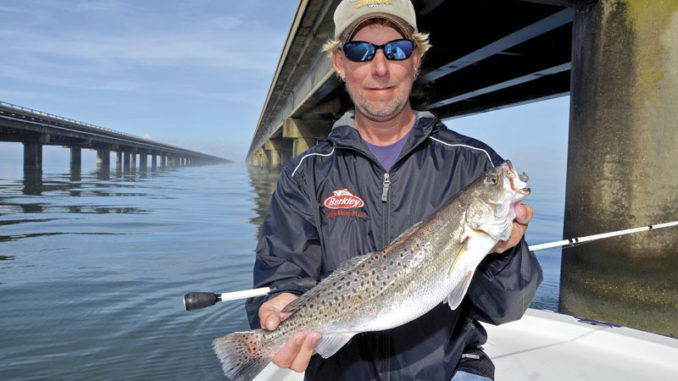
With the air temperature hovering about 28 degrees, compounded by howling winds that multiplied the chill factor, few people would venture out to fish, particularly in an 18-foot skiff on a body of water as large and wide open as Lake Pontchartrain.
On such a day, most people would probably rather crank up the heater and stay home to watch television, especially on Super Bowl Sunday.
But on Jan. 31 1999, Kenny Kreeger with Lake Pontchartrain Charters in Slidell braved the horrible weather and had the best fishing day of his life. Near the old Highway 11 bridge spanning the raging, white-capped lake, he tossed a Sparkle Beetle on a 3/8-ounce jighead toward the pilings holding up the decades-old structure.
“The fish were just slamming that day,” Kreeger said. “I already had a bunch of 5- to 6-pound trout in the box when the big one hit. I thought it was about a 10-pounder, so I put her in the livewell, but she went belly up. I kept fishing and caught my limit with five trout over 6 pounds, eight over 5 pounds and the rest over four pounds. I never caught a trout under 4 pounds that day. That was a heck of a day and year.”
Krueger’s big fish wound up weighing 11.99 pounds, the largest speckled trout caught in Louisiana since May 1950, when Leon Mattes landed a 12.38-pounder. While many Louisiana fishermen might not even think about specks until spring, the winter can produce quality action. Anglers probably won’t fill ice chests, but they might notch a better average, as Kreeger proved that blustery January day.
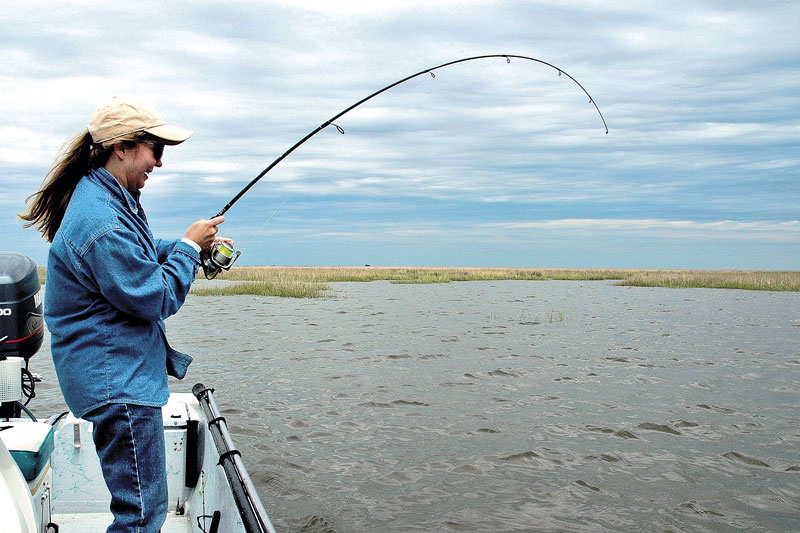
Go deep, go slow
When the thermometer bottoms out, look for the deepest water and fish as slowly as possible. In cold water, cold-blooded trout won’t hit baits worked the same way they would in May. With decreased metabolism, even hungry specks won’t move far or fast, but they might grab something staring them in the face.
“Trout migrate to deeper holes when the water gets cold,” Kreeger said. “In the winter, I use a 3/8-ounce, plain, lead jighead tipped with a plastic trailer and work the bait very slowly. I just bounce it a little off the bottom or pick it up an inch or two and let it fall back down. I work it like that all the way back to the boat. Trout get very lethargic in the cold water and might just watch a fast bait go past them.”
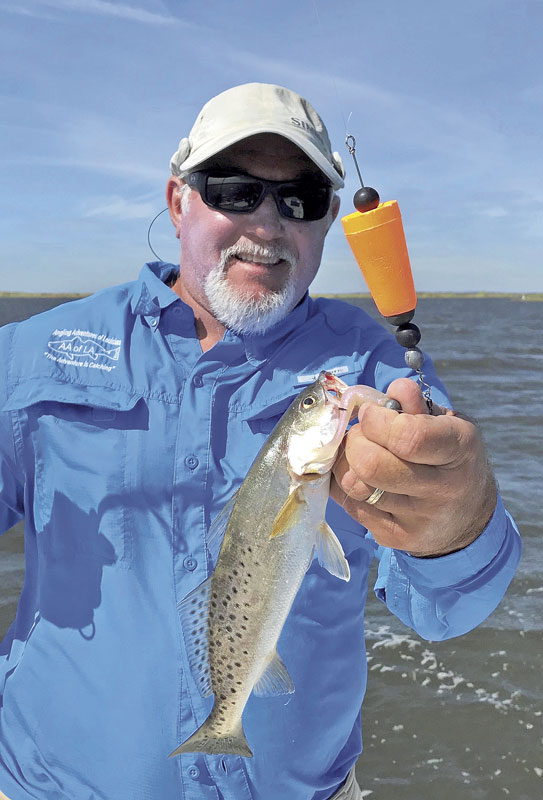
Across the vast, south Louisiana marshes, you typically find very little naturally deep water, except in a few larger lakes. Lake Pontchartrain averages about 12 to 15 feet deep. In cold water, fish often hold tight to hard structures, such as concrete pilings that hold up bridges. These concrete objects can absorb solar heat even on the coldest days and radiate that warmth into the surrounding water. On a chilly day, just a 1- or 2-degree difference in temperature could dramatically affect cold-blooded trout.
“In Lake Pontchartrain, trout are usually in 11 to 12 feet of water,” Kreeger advised. “When it’s cold, the trout like to lay up against those bridge pilings and won’t move very far. They get down into little holes at the bottom. We drag a lure right along the edge of those pilings. In the winter, the trout bite so faint that many people don’t even realize a fish hit. Sometimes, we just see the line twitch. People need to really pay attention.”
Surrounded by marshes and fed by rivers, both Calcasieu and Sabine lakes in southwestern Louisiana also regularly produce big trout. Both average about 5 to 8 feet deep but have deeper shipping channels. They also contain numerous oyster reefs and some artificial structures that attract trout. Both connect to the Gulf of Mexico through passes lined by jetties, hard structures that also absorb and radiate heat.
Marsh bayous, canals
In marshes near Delacroix, Hopedale, Venice, Golden Meadow and Cocodrie, anglers find uncountable bayous and thousands of miles of canals. Mostly built for oil exploration or extraction, these canals usually run about 8 to 15 feet deep, while surrounding marsh ponds might only hold a foot or two of water. Many ponds go almost completely dry when frigid north winds create hard, low tides in the winter.
“I fish the small, deep bayous, not the big bayous,” said Tommy Pellegrin of Custom Charters, who fishes the Cocodrie and Dularge areas. “I look for a bayou that bends and weaves a little, with a big flat about 3 feet deep and some grass or something on it next to water 6 to 8 feet deep. The trout come out of the deep water to feed. I also like to fish the curves in the bayous where we find the deepest water.”
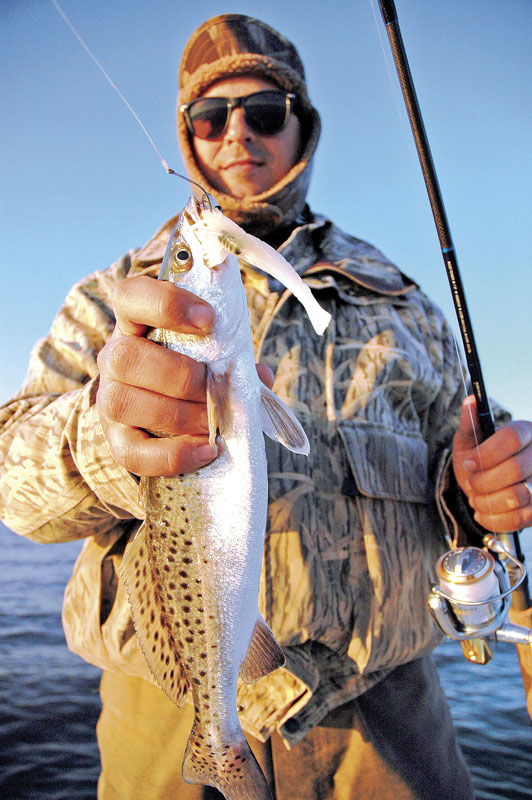
Work the entire depth range in these canals. Throw baits as close to the shoreline as possible and drag them out to the deepest water. Besides plastic enticements, anglers can thread fresh shrimp on jigheads and work them like soft-plastic baits. With natural baits, leave the offering still for long periods. If nothing bites, move it a few feet at a time.
“I like lures that imitate cocahoe minnows,” Pellegrin said. “I like a 3-inch minnow (olive green back/pearl belly). I usually use a 1/4-ounce jighead, but sometimes, I drop down to a 1/8-ounce so it falls slower. Let the bait settle on the bottom and then jump it up a little. Keep moving it slowly like that. If the bait passes in front of its nose, a trout will suck it up, but it won’t chase it.”
Many canals end in a wide, deep, turning basins. Perhaps a wellhead stood there or still does. When temperatures plummet, speckled trout drop into these deeper basins. In the right spots, where they find reasonable temperatures and little tide to fight, specks can stack up in huge numbers.
Slow water rocks
“In cold water, slower tides are better than fast tides because if the water’s cold, the fish are cold and not moving much,” Pellegrin said. “It doesn’t matter if it’s going in or out, as long as it’s moving a little. If it gets extremely cold, I fish dead-end canals where the tide won’t be moving much.”
Most people consider a popping cork a warm-weather technique, but it can produce fish year-round. Sometimes, winter temperatures remain moderate, or a warming spell passes through, making trout feed more aggressively. On a falling tide, toss a live shrimp, minnow or plastic imitation under a popping cork as far up these tiny drains as possible. Let the tide carry it out naturally.
“When we get some warmer days during the winter, the water temperature might rise, and trout will become more active,” Pellegrin said. “In the winter, I prefer a quieter cork. I don’t want it to make a tremendous amount of noise, because trout are not as aggressive as they would be in the spring or summer. I like the old-style, clip-on oval corks because they make the least noise, but they still move the bait. Under the cork, I fish a PowerBait Rattle Shrimp or a 2-inch minnow imitation in a glow color. I dip the tail in chartreuse dye.”
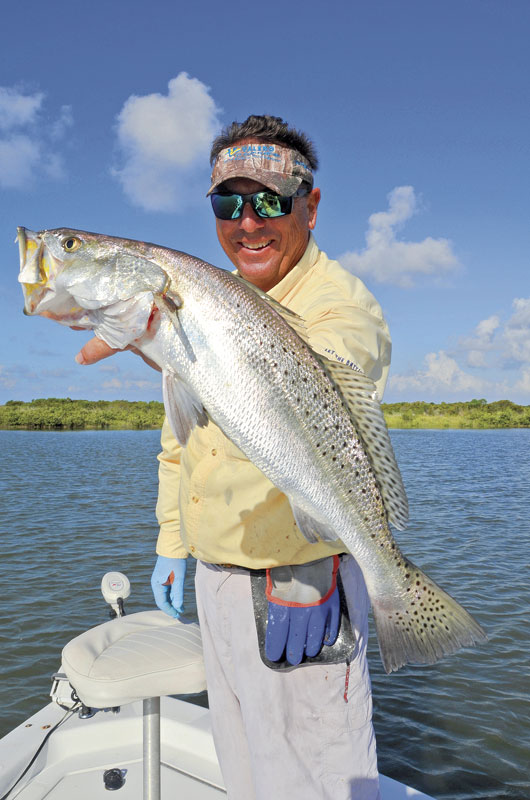
Barrier island ditches
When he wants to catch bigger specks, Pellegrin heads to barrier islands like Timbalier or Isles Dernieres at the edge of the Gulf, where he finds deeper water and fishes larger baits, like 5-inch soft-plastic trailers on jigheads.
“I like to find deeper troughs and cuts in the islands, usually about 4 to 8 feet deep,” Pellegrin said. “Some deep cuts can produce good fish if people know where to look. In the right spots, we catch some big, aggressive trout. In the winter, trout by the islands average about 15 to 20 inches, but we catch many that exceed 20 inches. The inside waters produce better numbers, but trout will be smaller, about 12 to 14 inches long on average.”
Many people look for diving seagulls during warmer months, but you might spot some bird action in the winter. When water temperatures drop, trout commonly feed on smaller prey. Watch for smaller birds on colder days.
“Many people call the little terns ‘liar birds,’” Pellegrin said. “Most of the time, the terns dive on small fish like anchovies. During the winter, even a little liar bird diving could mean trout feeding on those same, small fish. Don’t ever pass up any bird activity during the winter, because that’s definitely a sign of bait in the area.”
On cold days, trout tend to congregate in places that offer the best combination of comfortable temperatures and food. In the right spot, an angler could put a bunch of fish in the boat quickly, with little competition. Any cast might produce the trout of a lifetime, even on the coldest day. Just ask Kenny Kreeger.

